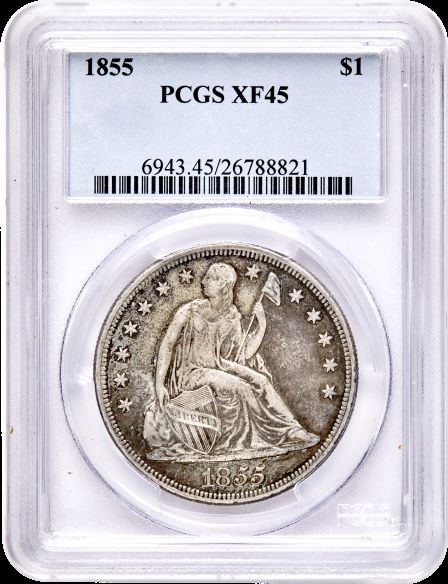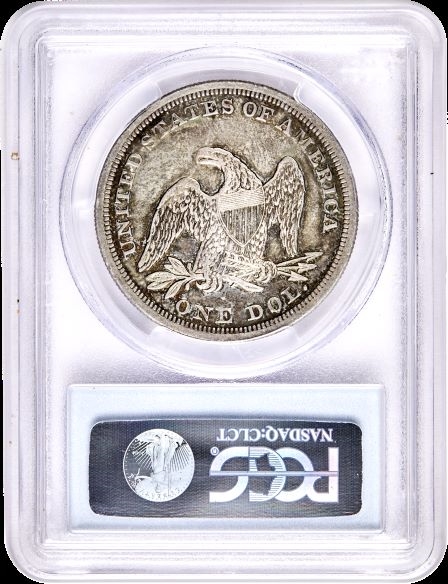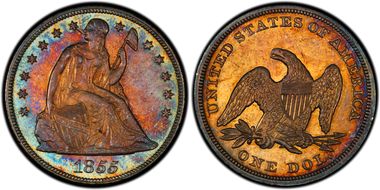1855 $1 XF45 认证号26788821, PCGS号6943
拥有者评论
A choice original example of this very scarce date, well struck with nice silvery gray toning with hints of green and blue over glossy fields.
专家评论
Q. David Bowers
The following narrative, with minor editing, is from my "Silver Dollars & Trade Dollars of the United States: A Complete Encyclopedia" (Wolfeboro, NH: Bowers and Merena Galleries, Inc., 1993).Coinage Context
Another "trade dollar": Like its 1854 predecessor, the 1855 Liberty Seated was primarily a trade coin. I believe that many were exported and melted.
The almighty dollar: In 1855, Washington Irving's Wolfert's Roost was published, and it contained a reference to the dollar which has been the basis of a phrase used many times since: "The almighty dollar, that great object of universal devotion throughout our land, seems to have no genuine devotees in these peculiar villages."
Numismatic Information
Circulated grades: Circulated examples of the 1855 Liberty Seated dollar are few and far between, and finding an acceptable specimen of this date has never been an easy task. However, in comparison to many other areas under the numismatic rainbow (Morgan dollars being an obvious instance), 1855 silver dollars are relatively inexpensive in proportion to their rarity.
Mint State grades: Mint State 1855 dollars are extremely rare. I have only seen a few of them in my experience over 40 years, and even large collections are apt to lack a Mint State example or to have a Proof instead. The Dr. Arthur S. Weisel Collection, dispersed by Chris Napolitano in April 1992, had an MS-62 (PCGS) coin; in nine years of looking, this was the best circulation strike the owner could locate (in May 1992, PCGS regraded this coin to MS-63).
In 1982, Bruce Amspacher stated that he knew of only one that could be called Uncirculated, never mind a higher grade such as MS-63 or MS-65. (Article, "Liberty Seated Dollars," in the Monthly Summary, Coin Dealer Newslelter, July-August, 1982.) Here, indeed, is one of the greatest sleepers among circulation strike Liberty Seated dollars. The importance of this date in this grade cannot be overestimated. All known Mint State circulation strikes have somewhat dullish lustre.
Varieties
Circulation strikes:
1.Normal Date: Breen-5452. Circulation strikes were made from a single pair of dies. Slanting (italic) 5s in date.
Dies prepared: Obverse: Unknown; Reverse: Unknown
Circulation strike mintage: 26,000; Delivery figures by day: May 4: 9,000; May 10: 3,000; May 15: 4,000; June 25: 10,000.
Estimated quantity melted: Unknown
Circulation strikes:
Enabling legislation: Act of January 18, 1837 Designer of obverse: Robert Ball Hughes (after Gobrecht)
Designer of reverse: Robert Ball Hughes (after Reich)
Weight and composition: 412.5 grains; .900 silver, .100 copper
Additional Information
Peale on Die Making
The following report is from the Proceedings of the American Philosophical Society, Philadelphia, January-April 1855, pp. 95-100, and contains a description by Franklin Peale on the subject of die making. Peale worked at the Mint from 1839 until he was discharged in 1854 for using Mint facilities for his private profit. More than any other individual at the Mint during his time, he devised many innovations in the fields of die making and coinage. (Also see "A Visit to the Mint in 1861," under Additional Information, 1861, below.) Peale's 1855 report follows:
"Mr. Peale made a communication on the subject of coinage, embracing a variety of facts and observations, particularly in relation to the processes of preparing and reproducing dies for monetary and medallic purposes; and, in connection therewith, exhibited electrotype and other copies of coins and medals.
"He said, that the observations he was about to offer to the attention of the Society were selected from his notes, upon numismatic operations, and were the result of many years of experience, whilst an officer of the government, in the department to which they refer.
"He further observed, that the enthusiasm which had always been an impelling principle whilst endeavoring to fulfill his duties, might have made him overvalue the matter, and that in now asking the attention of the Society, he was committing a similar error; in which case he could ask the indulgence due, and so often granted, under like circumstances.
"It cannot be doubted, that the coinage of the country, of high rank in the scale of nations, should bear evidence on its face, in the first place, of the condition and progress both of the fine, and mechanic arts, within its borders; and to insure, in the second place, the greatest degree of security against fraudulent imitations, or counterfeiting, which desirable object can best be secured by the employment of the highest grade of artistic talent in the design of the device, and its execution throughout, to the finished coin as issued from the mint.
"A brief notice of die-sinking, and the reproduction of dies for coinage, will be appropriate before proceeding further with the subject.
"In the advance of the mechanic arts, in modern times, great facilities have been devised therein. The arts of medal engraving and die-sinking have largely participated; rapid and exact mechanical means now take the place of the laborious and imperfect ones which formerly embarrassed this important art. I will endeavor to exemplify them as briefly as possible.
"The artist or designer models in a plastic material, such as wax or clay, a medallion portrait, or other device in relief, of sufficient size to permit freedom of handling, and facile study of effect; from this model a cast can be taken in plaster of Paris, or it may be electrotyped in copper. From the mold thus obtained, copies can be cast in hard metal, bronze or iron, which may be. further retouched or finished; at the will of the artist.
"The model, prepared as above, is placed in the portrait lathe, of which we arc indebted to the French. By means of mandrels, revolving in equal periods of time, upon one of which the model is placed, and on the other the material for the copy or reduction, in front of which mandrels a bar is made to traverse, carrying a tracer, which passes over the face of the model, touching, in succession, every part of the model in a spiral line from centre to circumference, or vice versa, a tool on the same bar, opposite the mandrel bearing the material, necessarily obeys the same motions, and is thus made to cut a facsimile of the model, the construction of the whole being such as to admit of any proportionate relation in size. By means of this lathe, rapid and exact reductions are made in steel, with an infinitely decreased amount of labor, and having the great advantage as far as coining purposes are concerned, of retaining faithful proportionate relations in the different denominations of pieces bearing the same device. The lettering of legends is usually put in at this stage of proceeding by hand, as well as minor and detached parts.
"This, in general but concise terms, is the mode of operating, when a new device is to be executed for a medal or coin; but at this point an important distinction exists, and we must separate, by a very marked division, the two branches of the art, that of medal-striking and the coining of money. In the former, repeated blows upon a disc of metal, with intervening annealings, enable a device, of any degree of elevation, to be brought up, as it is technically termed, whilst in the latter we are restricted to a single blow, or action of the coining press, upon the prepared disc or 'blank,' and hence the necessity of much judicious care and skill in the device and engraving as shall give the strongest effect to the coin, with the least degree of elevation; a most desirable object, when it is known that each pair of dies is required to strike off pieces, numbering from 50 to 200 thousand, with as little injury to the face as possible, as any difference in appearance of coin from the wear of the dies is to be deprecated.
"Remarks of importance, in relation to the character of the device, will be introduced in a subsequent part of this communication.
"The foregoing relates principally to the execution of new devices, and it is hoped they are sufficiently explicit to show the vast saving of labor derived from the process in comparison to the old plans of operating, in prosecuting which, the engraver was obliged to dig out the solid metal by slow and laborious means, taking impressions of parts as he progressed in plastic material, and consuming long periods of time, according to the elaboration, or magnitude of the device.
"Equal, if not superior facilities, have been applied to the preparation of the dies for coinage of money; the process in its most improved condition, was learned in the mint of Paris, and introduced by myself into the Mint of the United States, about the year 1836. It is the transfer from an original die, by pressure on a softened steel punch or 'hub,' as it is technically called, a facsimile in relief, which hub, after hardening, is used to strike in soft steel properly prepared, the impressions which, after turning off the superfluous metal, hardening, and tempering, and other preparations, form the ordinary coining dies.
"By the above described process, dies in indefinite and almost unlimited numbers, can be made complete, with the devices, legends and ornaments in perfect similitude, whilst, by the ancient process, they were separate operations, by hand, and, of course, no two could be made exactly alike, requiring skillful die sinkers to approximate to such a condition, if at all possible, whereas the present process needs only the manipulation of skillful mechanics.
"Were it not for the facilities, of which the above is a condensed notice, the four or five hundred pair of dies, now required for the service of the Mint of the United States and its branches, could not be furnished without a very large and expensive engraving establishment.
"When new devices are required, the best talent and highest grade of skill, within the command of the government, should be employed at any cost for its execution in the most perfect style. And, further, I do not hesitate to say, that if artistic talents and skill of sufficient eminence cannot be found in this country, to place our coin in the highest rank of the coin issues of the civilized world, we should look for and employ its aid wherever it can be found.
"The above views are sustained by the usages of the mints of France and England. In the former the original dies or matrices are procured by competition (concurrence),judged and selected by commissioners appointed for the purpose; and, in the latter, since the late reform, by competent artist selected for the purpose.
"Coining dies, it is evident to all acquainted with the subject, as above described, can be procured by the services of mechanics of good ordinary skill; and it is not necessary that they should be diesinkers by profession.
"I will not, I hope, be deemed irrelevant to introduce a few remarks on the mechanical relations and exigencies by which the devices of coins are controlled, and which have a most important bearing on the style and execution of them.
"It has already been said, and now repeated, that the coiner is limited by the nature of the service, to a single blow of the press in striking pieces of money; it is important, therefore, that the design of the device should be so disposed as to give the strongest effect with the least degree of elevation, not only for the purpose of giving the utmost degree of legibility to the impressions on the coins, and thus prepare them to retain their distinctness, during circulation, to the longest period of time, but also to save the dies as much as possible, under the severe usage to which they are subjected.
"Force and strength of expression in a coin are best attained by a judicious outline in strong relief, whilst the general relief is kept as much subdued as possible. In tact, the center of the device should not rise above a plane of which the outline forms the boundary. On the contrary, if a device on a coin rises in the middle it compels a reduction of the outline to faintness, producing a weak and unsatisfactory effect, is hard to strike, is soon obscured by abrasion, and entirely deprives the coiner of the opportunity of polishing the table or plain part of the dies, and background of the coin, the first being the usual technical term, a grave fault very often observed in what, if otherwise executed, would be works of high artistic excellence. The type of the species of relief alluded to, is found in the frieze of the Parthenon, where strong shadows from a bold outline, give the effect of depth by means well understood by the ancients, and of comparatively easy execution.
"The obverse of a coin should bear the strongest device, being the most important side, the reverse must be subsidiary, its bearings should therefore be simple, such as broad letters, a shield, wreath or other ornament in low relief, so that the force of the impression may be concentrated on the obverse. By this disposition the best effect is given to the most important side of the coin.
"The United States Mint labors under a disadvantage in this respect, the most of our pieces having devices on both sides, of equal depths, in consequence of which the force of the blow, and the necessary metal to supply the impression, is distributed between the two sides, thus making both weak, and losing the effect of a more judicious disposition.
"After long experience, observation and reflection on this subject, I am decidedly of opinion that the obverse of all coins should present the device of a head or profile, whether it be a 'composition emblematic of Liberty,' or a portrait. The likeness of our glorious Pater Patrice, Washington, might justly be considered the embodiment of republican liberty-or the classic head of high art, with the admitted exquisite beauty of the Greek school, are alike applicable. I do not desire to give a decided opinion relative to either, but I say the obverse should be thus engraved because, in the first place, the highest grade of artistic talent and excellence is required for its conception and execution, much more elevated than that required for the usual armorial or inanimate delineations; and, secondly, because its effect, when well and suitably executed for coining purposes, is better adapted to the mechanical exigencies which control the operation. The reverse should, as I believe, be plain and legibly lettered, with the denomination of the piece, in the middle of the field, surrounded by a wreath of rich composition, in low relief, with the usual legend around the border. The design of the wreath might contain the products of the North, West and South, the wheat, corn and cotton of our widespread domain.
"The disadvantages of the full-length figure of our silver coins, or' any other full-length figure, are these. The minute size of the head, hands, limbs and other portions, debars the artist from the ability to give the expression and finish that a high grade of art, under other circumstances, permits, and when executed, however well, interposes difficulty in transferring the impression to the coin. (The reference is to the current Liberty Seated design.)
"The various views, above presented, are sustained, and appear to have had their influence, by the best and most recent coinages of Europe.
"I have only to fear that 1 have not brought them in relief (to use an appropriate figure), with the force to which, as I respectfully conceive, they are entitled."
PCGS #
6943
设计师
Christian Gobrecht
边缘
Reeded
直径
38.10 毫米
重量
26.73 克
铸币数量
26000
金属成分
90% Silver, 10% Copper
更高评级数量
90
评级较低的钱币数量
32
地区
The United States of America
价格指南
PCGS 数量报告
拍卖 - PCGS 评级的
拍卖 - NGC 评级的
稀有性和存量估计 了解更多
| 所有评级 | 950 |
| 60或以上 | 32 |
| 65或以上 | 0 |
| 所有评级 | R-5.1 |
| 60或以上 | R-8.8 |
| 65或以上 | R-10.1 |
| 所有评级 | 4 / 30 |
| 60或以上 | 4 / 30 TIE |
| 65或以上 | 1 / 30 |
| 所有评级 | 10 / 45 |
| 60或以上 | 10 / 45 TIE |
| 65或以上 | 1 / 45 |























